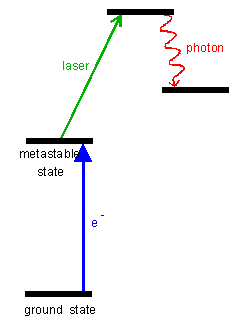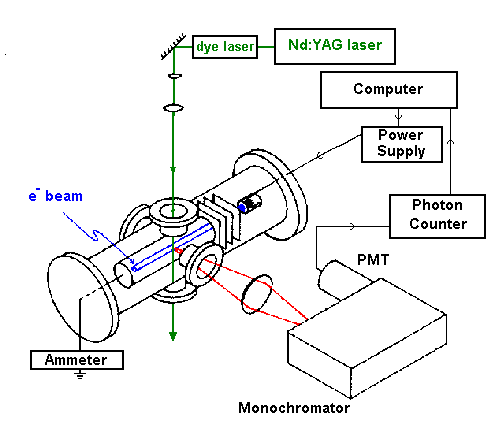Excitation out of the ground state into metastable states
Laser-Induced Fluoresence (LIF) System
What are Metastable States?
Atoms can be excited (by lasers, electron collisions, etc.) to energy levels above their ground states. Normally, these levels are short-lived and the atoms quickly decay (typically in few nanoseconds) back to the ground state. When the atom is excited into a level which is not allowed to quickly decay it is said to exist in a metastable level. These metastable atoms contain a lot of energy and are very important in real-world applications such as lasers and various plasmas. For example, the ubiquitous Helium-Neon laser works by electrons exciting the helium into its metastable levels. The helium atoms then transfer their energy to selective neon levels that generate the laser light.
In our lab we measure cross sections for electron-impact excitation into metastable levels from atoms initially in the ground state.
How do we measure the signal?
An atom is metastable because it can't decay by giving off a photon. So how do you detect the metastable atoms if they don't give off light?We use a laser to pump the atoms out of the metastable level into some higher level that can decay giving off light. The laser-induced fluoresence (LIF) is then detected by an apparatus similar to the chamber/monochromator system described elsewhere, except for the lasers. A Nd:YAG pulsed laser is used to pump a two-stage dye laser that forms the laser beam for LIF.

Absolute calibration of cross sections:
To place the results on an absolute scale, we measure the amount of signal with the LIF pump laser on and off. With the laser off, we measure only the apparent cross section into the higher level. With the laser on, we also measure an additional amount of signal due to excitation into the metastable levels that are pumped into the higher level. By knowing the fraction of atoms pumped into the higher state, we can find the cross section.Some experimental specs:
| Typical Laser Power: |
Nd:YAG - 250 mJ/pulse ( 13 nsec pulse @ 20 Hz) dye laser - 1 to 3 mJ/pulse |
| Target Density: | 1011 to 1014 atom/cm3 (10-5 to 10-2 Torr) |
| Energy Range: | 0 to 500 eV |
| Electron Beam current: | 150 µA at 100 eV |
| Gases studied: | Argon, Krypton, Xenon |
Recent Published Results
back to experiments list... back to home page